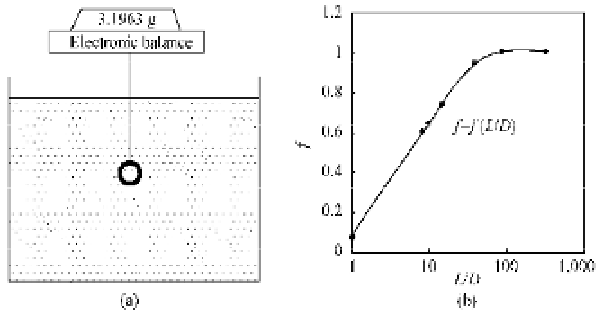Environmental Engineering Reference
In-Depth Information
falling in the liquid. If an object is immersed in or floating on the surface of a liquid, the force acting on
it due to liquid pressure is termed buoyancy. Archimedes found that the buoyancy is given by
J
V
(5.42)
F
b
where
F
b
is the buoyancy, J is the specific weight of the liquid,
V
is the volume of the object or the
volume of the fraction below the liquid surface. This is Archimedes law.
If, however, there are many suspended solid particles in the liquid, which have different densities from
the liquid, the buoyancy of the object in the mixture of the liquid and solid particles is different.
Wang (1987) studied the problem and found that if the size of the object is much greater than the
suspended solid particles,
L
> 50
D
, the buoyancy is given by
F V
(5.43)
in which
L
is the size of the object,
D
is the diameter of the suspended particles, and J is the specific
weight of the mixture of the liquid and the suspended solid particles. If the size of the object is smaller
than the diameter of the suspended solid particles, the buoyancy is the same as if the object was in the
pure liquid,
J
b
F V
If the size of the object is between
D
and
50D
, the buoyancy is given by
J
b
L
§·
F
Vf
[
J
(
J J
)
S
]
(5.44)
¨
©¹
b
s
v
d
where
S
v
is the volume concentration of the suspended solid particles,
f
(
L
/
D
) is a function of
L
/
D
.
Figure 5.23 shows the experimental setup of Wang (1987) and the curve of
f
(
L
/
D
) he obtained from
the experiment. If
L
/
D
is over 50,
f
(
L
/
D
) =1, and eq. (5.44) reduced to eq. (5.43). If
L
/
D
is less than 1,
f
= 0
and Eq. (5.44) reduces to (5.42).
Fig. 5.23
(a) Experimental setup of Wang (1987), in which a copper ball with diameter,
L
, submerged in a suspension
of solid particles is hung on an electronic balance, the figure shown on the balance is the difference of the weight of
the ball minus the buoyancy force acting on the ball. (b) Buoyancy coefficient
f
versus the relative size
L/D
(after
Wang, 1987)
In a special case of solid particles falling down in water, if all the particles have the same diameter,
each particle is acted on by almost the same buoyancy as in pure water. Although the buoyancy is the
same in this case the group fall velocity of the particles is smaller than that of a single particle falling in
pure water. An empirical formula is
c
m
ZZ
(1
S
)
(5.45)
v



Search WWH ::

Custom Search